Guest post by Alysia Mann Carey.
Since writing my last fieldwork diary entry, I have arrived in Salvador, Bahia, Brazil. This entry will discuss my participatory and collaborative research with the community-based political organization, Reaja (React), and the multimedia fieldwork analysis I am conducting with MAXQDA 2018.
Conducting Participatory and Collaborative Research
Since 2016, Reaja has transitioned from a campaign into a political organization that continues to provide direct service and action to community members, and this past August marks the two-year anniversary of the first Pan-African school in the country – The Winnie Mandela School of Political Consciousness and Community Action. Since its inauguration in 2016, the school has more than doubled in size, with 27 youth between the ages of 7 and 14 now attending the Winnie Mandela School, which is located in the working class, majority Black neighborhood of Engenho Velho de Brotas.
Over the past 13 years, Reaja has mobilized Black families and communities against state violence, which translates to the genocide of Black people across Brazil. This includes police that invade and occupy poor, Black homes and communities; killing Black people immediately and slowly on a daily basis; medical centers that are underfunded, understaffed, and located in substandard buildings; and a neglected public education system that erases Black resistance and minimizes Black history.
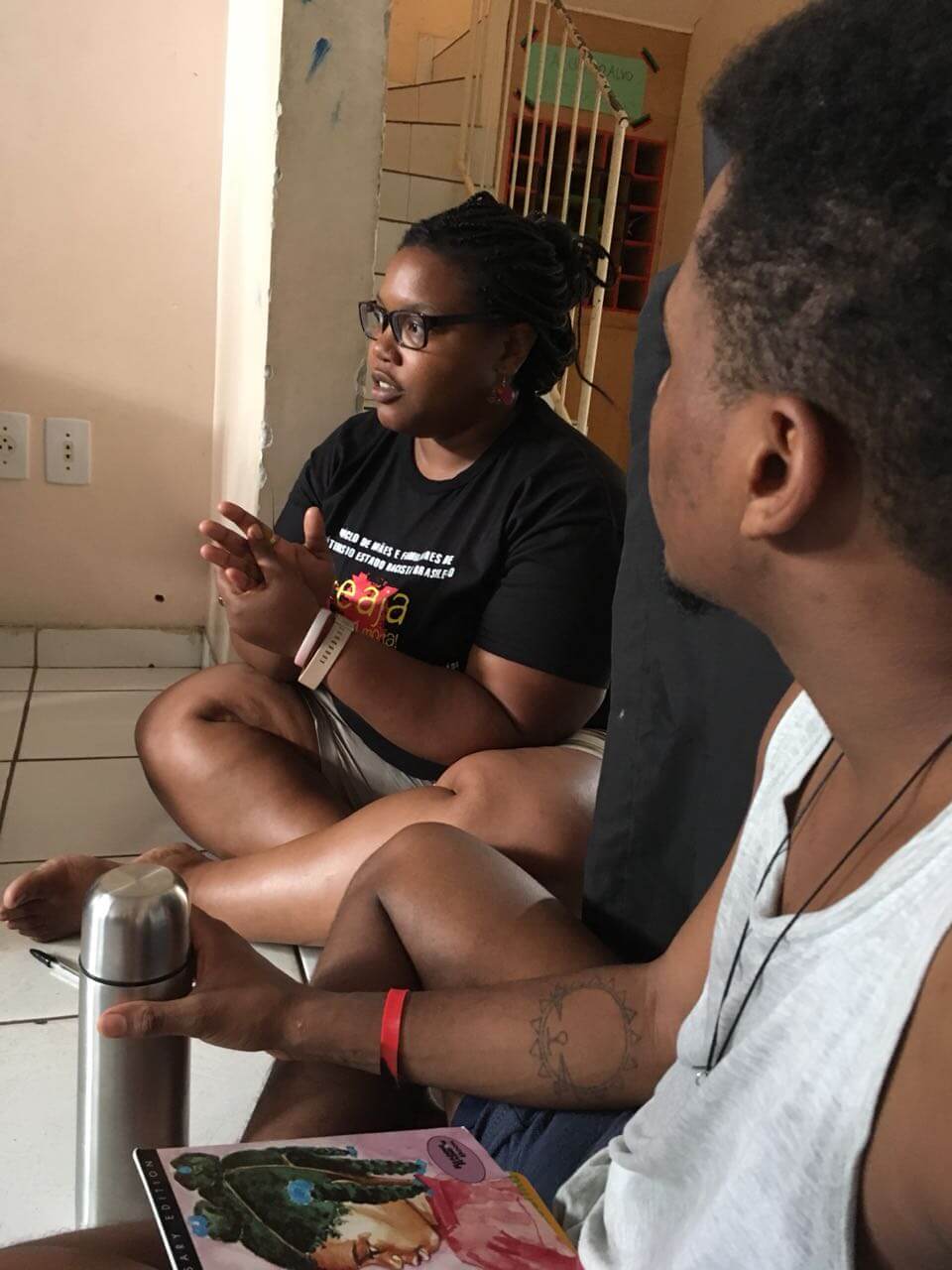
Alysia talking with students at the Winnie Mandela School about education and community organizing in Black communities in the United States
The pedagogical approach developed by teachers involves the everyday experiences of the youth: teachers speak the language of their students, meeting them where they are at because, at some point, these instructors have also been where their students are today. The teachers create open lines of communication between students and their families within the classroom setting that is accessible and relevant to the children’s daily struggles, and bringing these experiences in the street and at home into the classroom. The teachers (who are also organizers) emphasize collective methods and practices through this pedagogical approach. For example, during snack time, they eat in a circle on the floor, have the students take care of the space, help prepare the meals, wash their dishes, clean up at the end of the day. All these actions show them how they can love and care for each other, and the importance of solidarity and of unity.
Part of the work being done by React through the Winnie Mandela School is empowering members of the community as well as students to unlearn a number of harmful ideas, stereotypes, and practices that are deadly to Black communities, such as homophobia, transphobia, and misogyny. In an informal interview I had with one of the coordinators at the school and organizer with React, she mentioned how her identity as a poor Black trans-woman informs her organizing and approach to community and educational work at the school and in the organization.
Gathering and Analyzing Multimedia Fieldwork Archives with MAXQDA
Using MAXQDA’s “Document Browser”, I have been able to write and store my daily notes, write reflections, literature, and theoretical memos, and code some of the themes that have emerged. One of the ways this documenting feature has helped the organization beyond my research is by writing and translating documents to update the international community about the radical work being done by the organization and the school.
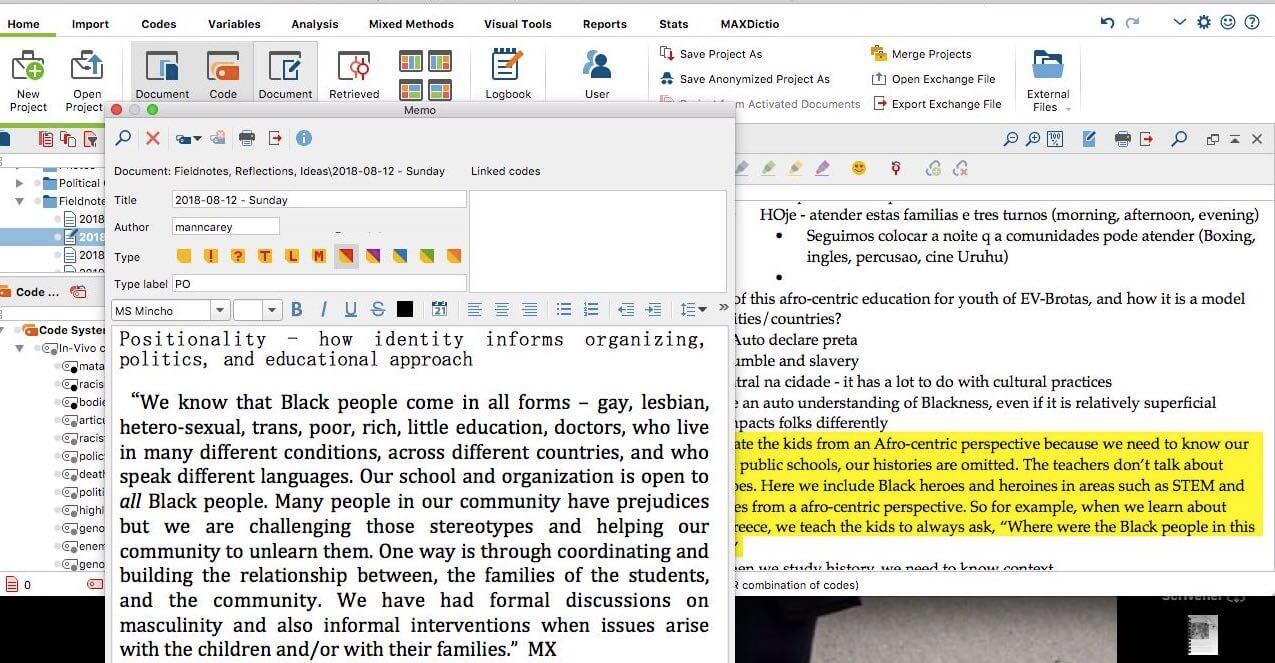
Writing and Coding Notes
This year, the 6th International March against the Genocide of Black People is bringing the march to the home community of Engenho Velho de Brotas. While the organization has, and continues to be, simultaneously local and global, this year’s march represents a new trajectory for the organization: to (re)envision and realize the political possibilities for the future of Black life in this community, this country, and this world. Taking the lead this year were the 27 students attending the Winnie Mandela School.
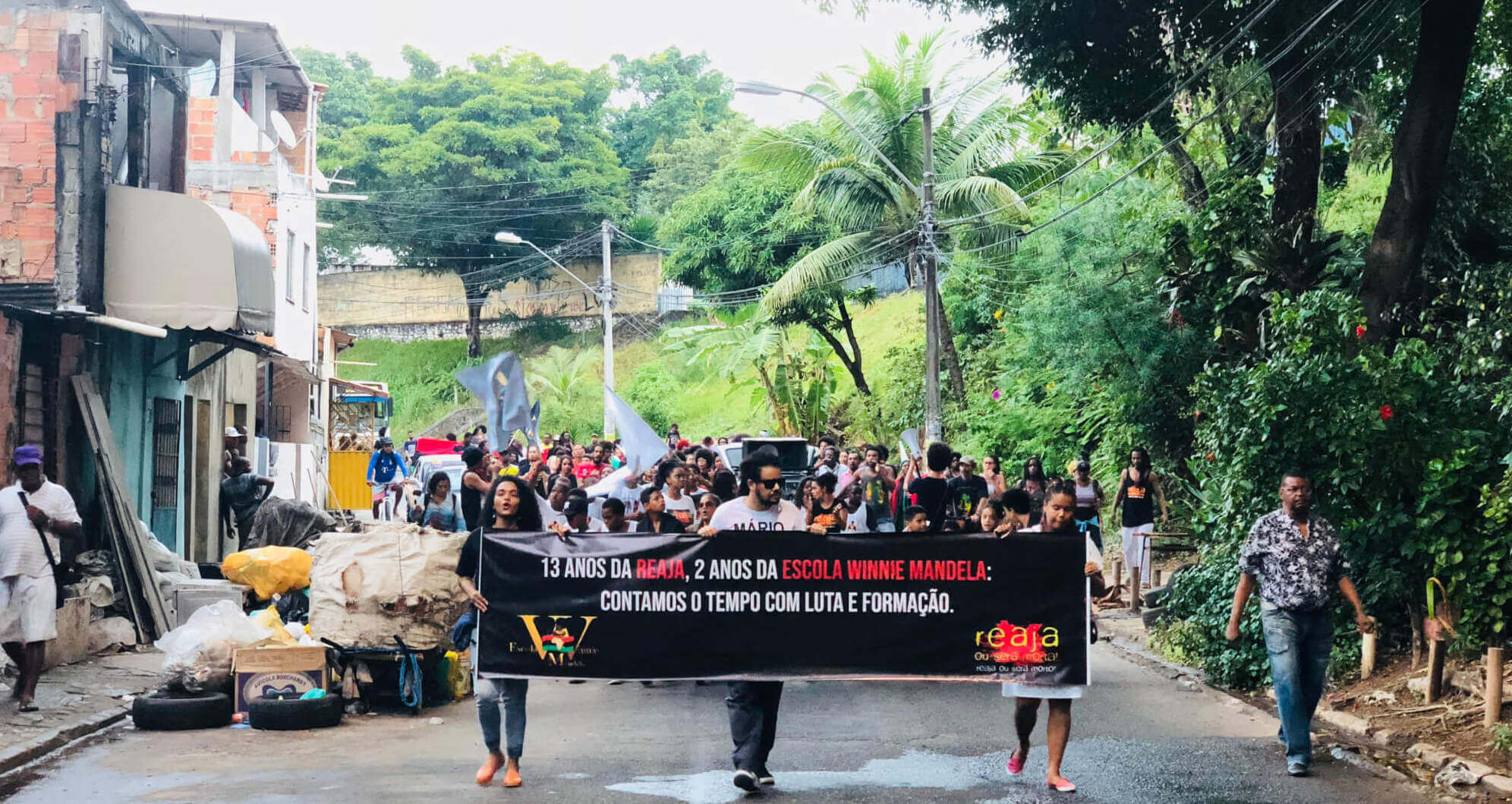
Students in the Linha Uhuru leading this year’s March
To end the march, the students were reciting a pledge to “protect the lives of black people” when the police arrived and used sirens to try to drown out the children’s voices. I used a MAXQDA memo to reflect on this experience and provide a transcript of the pledge the students were reading.
Using MAXQDA, rather than a simple text-writing program, is especially helpful when I am analyzing multimedia files, such as photographs and videos. One of the things I like about MAXQDA’s coding feature when analyzing photos is that I can select specific areas of the image that I would like to code. You can zoom in and out of the image, rotate it, and then select specific areas of the image to drag and drop onto a code.
I did this with the arrival of police cars to indicate the presence of the state (code: police) and the use of their sirens as a form of violence (code: state violence). This way, when I retrieve my coded segments, the pieces of the image that are relevant to my analysis will appear just as any coded text segment does.
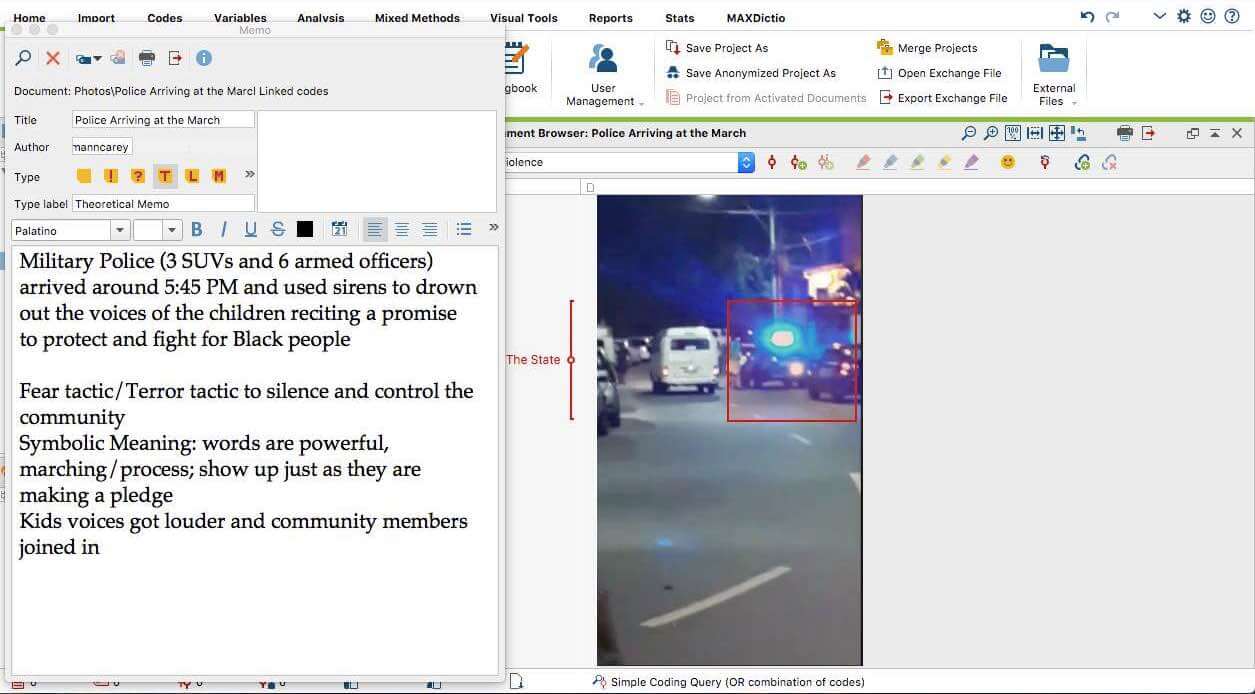
Coding Photos and Memo Writing with MAXQDA
To close out the evening, the students also released a rap video they wrote and recorded as part of their hip-hop class this semester. The title of the song is “Estellas Pretas” or “Black Stars”. I used MAXQDA’s Multimedia Browser to transcribe and analyze the video I took of the students performing the song.
I was able to transcribe the lyrics and then translate them into English so that the amazing work being done by the youth can reach an English-speaking audience as well. As you can see in the image below, I was able to transcribe in Portuguese with timestamps using MAXQDA’s Transcription Mode and then play back the video with the transcription while translating in a memo window. By doing all of the multimedia analysis in MAXQDA, this task was both faster and easier because all of the information is stored in one project.
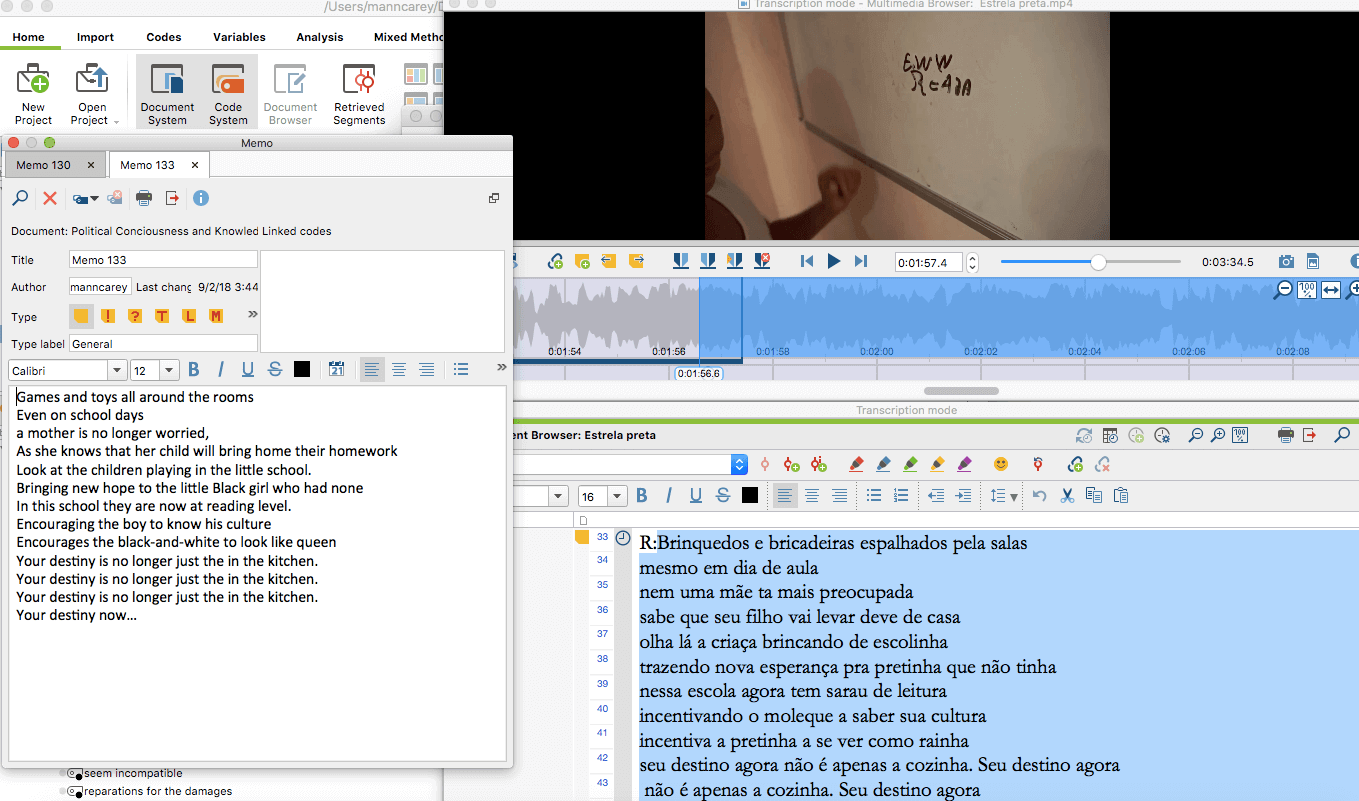
Transcribing Videos with MAXQDA
What’s Next
As I continue, I look forward to exploring further visual tools to help with the analysis and research methodology I am using on my research project. One of the challenges I am coming across at this early stage is that, like most qualitative research projects, some of the segments I code fall into multiple categories. I do not think that this is a bad thing, but I need to explore ways to tease this out more in advanced rounds of coding and analysis with MAXQDA 2018. Perhaps it’s a matter of creating stronger, more precise categories, but I do not want to limit my options at this early stage.
I think that in the next month, I will start to use MAXQDA’s Visual Tools to get a better sense of where these overlaps are and how to explore them more in my write-ups, and any gaps that may be present in the research. I will also continue to do participatory and collaborative research and the next step in my research is to begin to conduct interviews. The organization is also working on an anthology and I will be one of the contributors.
I will be writing about my experiences at the school and in the organization and I will continue to use MAXQDA to draw out the key themes, connections, and relationships from my multimedia documents as well as my written notes, observations, and reflections. I will let you know how I solved these issues in my project as well as update you on the progress in my research journey in my next and final fieldwork diary entry.
Thus far, these last couple months have been rewarding and intense, with lots of deep conversations and late nights working. But the work being done here is life changing, and this is evident within the community, with the students and with myself. I truly believe that there is much that other Black/Afro-descendant communities around the world and the international community more broadly can learn from the political work and organizing Reaja is doing here in Engenho Velho de Brotas. If anyone would like to know more about the school and how to support it, please feel free to contact me through the MAXQDA Research Grants team: grants@maxqda.com.
Editor’s Note
Alysia Mann Carey is a recipient of MAXQDA’s #ResearchforChange Grant. She is a PhD candidate in Political Science at the University of Chicago, USA. Her dissertation titled, “I felt the hand of the government in my womb: Black women, state violence, and the transnational struggle for life in Brazil and Colombia” will take an ethnographic approach to the experiences of Afro-descendant women in two countries. She is currently in the field and will share one more fieldwork diary entry with us soon!
